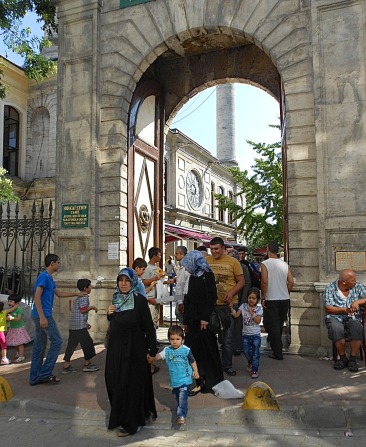Tucked away in the back streets of conservative Fatih in Old İstanbul there’s a mosque that boasts a particular treasure. The Hırka-ı Şerif is a garment believed to have belonged to the Prophet Mohammed that was bequeathed by him to Veysel Karani, a Muslim mystic from Yemen whom he had never met but presumably greatly admired. Karani’s descendants eventually arrived in İstanbul in the 17th century during the reign of Sultan Ahmed I whereupon the sultan persuaded them to put it on display in a house in Fatih. In the 18th century Sultan Abdülhamid I had a special kiosk constructed to show off the robe. Then in the mid-19th century Sultan Abdülmecid commissioned the current Hırka-ı Şerif Cami with a room specially designed to house the robe. It’s here that the faithful are allowed to view it as a special treat during the month of Ramazan.
Curious to see what it looked like, I joined a throng of women, most of them clad in the chador-like black robes of the Nakşibendi sect. My curiosity was piqued, I have to admit, not so much by religious sentiment as by what appeared to be a real howler of a mistranslation. According to the information board attached to the wall of the mosque the “Hırka-ı Şerif” was a “sacred cardigan”, but while I was sure that this was laughably wrong (no one, surely, would have been wandering the scorching desert of the Arabian Peninsula in the 7th century wearing a button-through woolly overgarment) I was less sure what the notice should actually have said.
The easiest way to have found out, I suppose, would have been to join the crowds in the Topkapı Palace’s Safekeeping Room where the Hırka-ı Saadet, also worn by the Prophet, is on permanent display. In Afyon’s new Mevlevihane Museum I’d seen the sort of black cloak worn by the whirling dervishes described as a “hırka” which seemed a more likely translation. Still, doubt lingered in my mind, hence this quick foray into Fatih.
On the threshold of the chamber we women removed our shoes and placed them in plastic bags. Then up the stairs we poured, trying hard not to knock into each other in our excitement. Luckily the crowds parted to let through an elderly woman who was being half-led, half-dragged along by her relatives while someone rushed to take over all the bags in which their shoes were stored. A hand rested briefly and reassuringly on my arm – I had wondered whether I, a gavur (infidel) would be allowed to enter such a holy place at such a holy time. Soothing religious music played in the background. A disembodied voice implored us not to take photographs.
At the top of the stairs we found ourselves in a corridor that wound round the interior of the mosque allowing us to look down on the men praying there without being seen. Purple curtains heavy with thick gold embroidery shrouded the outside windows. Then suddenly we were entering the shrine and passing in front of a glass case in which were set out a very moth-eaten “takke (a fez-like tall hat)”, a hessian belt, a piece of the Prophet’s beard enclosed in a small capsule and last but by no means least the “hırka” itself.
Aaah, so that’s what it actually is. Not a cardigan at all but a creamy coloured garment woven from camel hair that looks more like a shortened kaftan than a cloak.
But, alas, as at all such exhibitions, there were far more people wanting to view than there was time for them to do so at their leisure. “Move along, please,” said the custodian, or Turkish words to that effect, and off we went and down the stairs and out into the street where itinerant traders had set up stalls selling prayer rugs and rosaries and dates trucked in from Baghdad and tiny bottles of holy Zam Zam water from Mecca.
Actually, there was a longer queue in the courtyard to view the mosque’s other relics that can be seen every Friday anyway. But by then I was sweating profusely in my modesty sleeves and headscarf. I knew what the hırka was now. That was quite enough for one day.
Written: 20 July 2013


